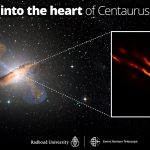Scientists show how planets form in binary systems without getting crushed
Astronomers have developed the most realistic model to date of planet formation in binary star systems.
The researchers, from the University of Cambridge and the...
Scientists find first evidence of water vapor at Jupiter’s moon Ganymede
For the first time, astronomers have uncovered evidence of water vapor in the atmosphere of Jupiter's moon Ganymede.
This water vapor forms when ice from...
Scientists find an exoplanet with the potential to form moons
Astronomers at the Center for Astrophysics | Harvard & Smithsonian have helped detect the clear presence of a moon-forming region around an exoplanet —...
The moon has been mildly preventing coastal erosion, in the 2030s, that protection ends
Planet Earth is currently experiencing an unprecedented warming trend.
Average global temperatures are rising at an accelerated rate in response to greenhouse gas emissions produced...
Scientists pinpoint the heart of the nearest radio galaxy
The Event Horizon Telescope Collaboration, which is known for capturing the first image of a black hole in 2019, has now imaged the heart...
Scientists find a new type of star dust in Allende meteorite
Scientists have discovered a new type of star dust whose composition indicates that it formed during a rare form of nucleosynthesis (the process through...
Scientists detect previously unseen star formation in our Milky Way galaxy
Astronomers using two of the world’s most powerful radio telescopes have made a detailed and sensitive survey of a large segment of our home...
Scientists use seismic data to look inside Mars for the first time
Since early 2019, researchers have been recording and analyzing marsquakes as part of the InSight mission.
This relies on a seismometer whose data acquisition and...
Where can we find a fifth force of nature?
We know of four fundamental forces of nature, with no signs of a fifth.
But dark matter and dark energy make up over 90% of...
Scientists take pioneering image of massive jet spewing from black hole
Scientists anchored by the Event Horizon Telescope Collaboration, which is known for capturing the first image of a black hole in the galaxy Messier...










